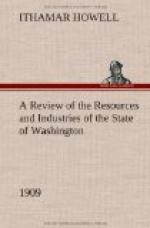Of the trees the fir is pre-eminently useful, and more than half of the forests of the state are fir trees. It is of greater strength than any of the others and hence is used for all structural work where strength is of special importance. It is rather coarse grained, but when quarter sawed produces a great variety of grains very beautiful and capable of high finish and is extensively used for inside finishings for houses as well as for frame work. Its strength makes it ideal for the construction of ships. The yellow pine is strong, medium grained and well fitted for general building purposes, and is very extensively used in eastern Washington.
Cedar is very light and close grained and is chiefly used for shingles, and for this purpose has no superior. The cheaper grades are also used for boxes and sheathing for houses and many other purposes.
The spruce furnishes an odorless wood especially useful for butter tubs; for shelving and similar uses it is superior to either the fir or cedar. It is a white, close grained lumber, and appreciating in value.
The hemlock, whose bark produces tannin for the tanneries, is also a close grained light wood coming more and more into [Page 19] general use, for many purposes, especially where it will not be exposed to the weather.
Logs frequently seven feet in diameter require big saws, and big carriers 50 to 100 feet long, and hence Washington has probably the largest sawmills in the world.
Our lumber is used at home and shipped all over the world to make bridges, ships, houses, floors, sash, doors, boxes, barrels, tubs, etc. Factories for the manufacture of wood products are scattered all over the state. Most of the sawmills and some factories are driven by steam made by burning sawdust, slabs, and other refuse of the mills. Coal and electricity, however, are both in use.
COAL MINING.
The mining of coal for foreign and domestic purposes is one of the most important of Washington’s industries. The annual output of the mines is about three million tons, worth about eight million dollars; Fifty thousand tons of coke are made annually, worth at the ovens about $300,000. The coal mining industry gives employment to 6,000 men. The production of coal for 1907 was distributed as follows:
Kittitas County, tons 1,524,421 King County, tons 1,446,966 Pierce County, tons 612,539 Lewis County, tons 101,275 Thurston County, tons 33,772 Whatcom County, tons 3,160 Clallam County, tons 300
The coke nearly all comes from Pierce county.
Nearly forty different corporations and individuals are engaged in coal mining. The coals thus far commercially mined are chiefly lignite and bituminous. These coal measures lie along the base of the foothills, chiefly of the Cascade mountains. Higher up are some mines of anthracite coals, not yet on the market for lack of transportation. As far as discovered they are chiefly near the headwaters of the Cowlitz river in Lewis county. Coal forms the largest factory in furnishing steam for the mill roads. Some of the railroads, notably the [Page 20] Northern Pacific and Great Northern, own their own mines and mine the coal for their own engines and shops.




